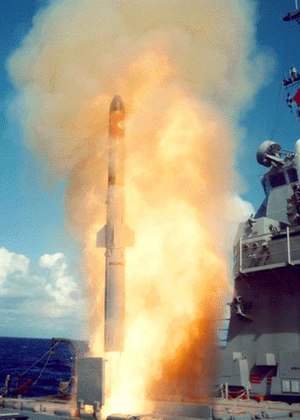RUM-139 VL-ASROC
| RUM-139 VL-ASROC | |
|---|---|

RUM-139 launching from a VLS cell
|
|
| Type | Standoff Anti-Submarine Weapon |
| Place of origin | United States |
| Service history | |
| In service | 1993 |
| Used by | United States Navy, Japan Maritime Self-Defense Force, and others |
| Production history | |
| Manufacturer | Lockheed Martin |
| Produced | 1993 |
| Specifications | |
| Length | 4.5 meters (15 ft) |
| Warhead |
Mk 46 torpedo Mk 54 torpedo |
|
|
|
| Engine | Two-stage solid-fuel rocket |
|
Operational
range |
22 kilometers (24,000 yd) |
|
Guidance
system |
Inertial guidance |
|
Launch
platform |
Surface ship |
The RUM-139 VL-ASROC is an anti-submarine missile in the ASROC family, currently built by Lockheed Martin for the U.S. Navy.
Design and development of the missile began in 1983 when Goodyear Aerospace was contracted by the U.S. Navy to develop a ship-launched anti-submarine missile compatible with the new Mark 41 Vertical Launching System. The development of the VLS ASROC underwent many delays, and it was not deployed on any ships until 1993. During this development, Goodyear Aerospace was bought by Loral Corporation in 1986, and this defense division was in turn purchased by Lockheed Martin in 1995.
The first VLS ASROC missile was an RUR-5 ASROC with an upgraded solid-fuel booster section and a digital guidance system. It carries a lightweight Mark 46 homing torpedo that is dropped from the rocket at a precalculated point on its trajectory, and then parachuted into the sea. Beginning in 1996, the missile was replaced by the newer RUM-139A and subsequently the RUM-139B. The torpedo has remained the Mark 46, though at one time an improved torpedo called the Mark 50 was proposed and then cancelled. Since October 2004 the RUM-139C is now in production with the Mark 54 torpedo.
The vertical-launched missile first became operational in 1993, with more than 450 having been produced by 2007. It is 4.5 meters (15 ft) in length, with a firing range of about 11.8 nm or 22 kilometers (24,000 yd).
...
Wikipedia
